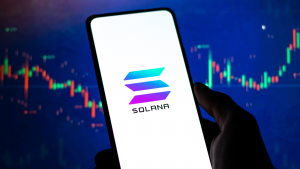
For several weeks, the news regarding cryptos centered heavily on the Merge – a transition from the energy-intensive consensus mechanism called proof-of-work (PoW) to the much more efficient protocol proof-of-stake (PoS). Unfortunately, the disappointing price action for virtual currencies suggested that the sector suffered from the “buy-the-rumor, sell-the-news” syndrome. Moving forward, the blockchain community must now worry about what I would call the ‘Tightening.’
Of course, I’m referencing the Federal Reserve and its decision last week to hike interest rates by 0.75%. According to the Wall Street Journal, the latest action represented the third consecutive hike of 0.75%, meaning that the central bank is committed to tightening the money supply. Such action will likely impart deflationary forces to the market, particularly for risk-on assets like cryptos.
Moving forward, investors must be aware of the paradigm shift in financial incentivization. Under an inflationary cycle, the dollar’s purchasing power declines, creating an active incentive to do something with cash: either spend it or invest it.
In a deflationary environment, purchasing power rises, creating an incentive to passively sit on cash. Unfortunately, that’s not helpful for the valuations of risk assets. Still, long-term investors may want to consider the compelling discounts on these top cryptos, in this environment.
Bitcoin (BTC-USD)
Source: Sittipong Phokawattana / Shutterstock.com
Throughout most of the Sept. 26 session, Bitcoin (BTC-USD) – the undisputed king of cryptos – traded beneath the $20,000 level. That said, Bitcoin bulls were able to push BTC beyond this psychologically important threshold, though barely. As of today, Bitcoin is back down below $20,000, and has even breached the $19,000 level again.
With Bitcoin bouncing around in this range, there are many questions to be answered. Could this volatility represent the beginning of a recovery in cryptos? As much as I would personally like to believe in this outcome, we must be realistic. With the Fed’s commitment to tackling rising inflation through interest rate hikes, the framework for virtual currencies runs counter to the economic winds. In addition, central bankers around the world have implied that more tightening will be on the way. This is likely to mean that inflation could remain stubborn, boding poorly for blockchain-derived assets.
It’s not all bad news in the sense that cryptos, as an industry, generated incredible fanfare last year. Therefore, at some point in the future, the sector may make a comeback. Until then, investors can strategize their entry points.
If Bitcoin fails to hold the 20K level over the medium-term, consistent long-term horizontal support stands around $9,300.
Ethereum (ETH-USD)

Source: Vladimir Kazakov / Shutterstock.com
If cryptos were humans, entire communities would be ragingly jealous over Ethereum (ETH-USD). For the longest time – with the intensity reaching a fever-pitch in the last several weeks – the Merge dominated blockchain-related headlines. It’s not without good reason. As The New York Times mentioned, the Merge, while presenting possible opportunities, also carried significant risks.
Given the incredible complexities of the transition from PoW to PoS, it may be a small miracle that the Merge was successful, and did not plunge all cryptos into a worse bear market. But now that the event is in the bag, investors don’t have much to look forward to. That’s why I mentioned the concept of buy the rumor, sell the news. Excessive hype tends to produce poor outcomes.
Even more problematic, the event that is coming up – the Tightening – isn’t one that folks necessarily want. After all, many doom-and-gloomers on YouTube advocated investing in alternative assets (gold, cryptos, etc.) to protect themselves from the collapsing dollar. However, the surging U.S. dollar has provided yet another headwind for this sector.
If Ethereum can’t maintain its present $1,300-plus price tag, a sub-$1,000 price – perhaps down to $600 – is not out of the question.
Tether (USDT-USD)

Source: DIAMOND VISUALS / Shutterstock.com
To avoid charges of hypocrisy, let me be clear upfront: I maintain a small position in Tether (USDT-USD), the popular stablecoin. However, I sold the bulk of my USDT earlier, publicly broadcasting this move. Fundamentally, given the Fed’s monetary framework, I see no reason to hold excessive Tether (or any other stablecoin).
Let’s consider the primary purpose of a stablecoin – convenience. While exchanges and wallet services have improved substantially over the years, a cumbersome process still exists regarding the conversion from fiat currency to virtual currency. By already having funds secured in stablecoins like USDT, traders can actualize opportunities right away.
However, if you don’t frequently and actively trade cryptos, the convenience factor for stablecoins doesn’t make sense now. So what if you missed a dip-buying opportunity? Under a deflationary ecosystem — the aforementioned Tightening – digital assets may have more to fall before they rise.
Also, should a “bank run” materialize in Tether, you’re going to be very happy you sided with Federal Reserve notes.
Ethereum Classic (ETC-USD)

Source: Shutterstock
Out of the non-Ethereum alternative cryptos or altcoins available, I’m currently most interested in Ethereum Classic (ETC-USD). To recap for the benefit of newcomers, ETC actually represents the original Ethereum blockchain. However, a security breach forced many developers to implement a hard fork or offshoot blockchain network, which eventually became the Ethereum that everyone knows today.
Yet a number of blockchain purists didn’t agree with the hard fork. These developers stuck with the original chain, which took on the label Ethereum Classic. Since then, it’s been a struggle to maintain security on the network, with ETC suffering several hostile attacks. Nevertheless, the developers continue to persevere.
What’s significant about this loyalty to the original chain is the underlying PoW consensus mechanism. Unlike Ethereum 2.0, Ethereum 1.0 has no plans to migrate to PoS. Fundamentally, this decision should make ETC more meritocracy based. Essentially, those who want to earn more ETC rewards simply need to ramp up their crypto-mining rig.
That said, ETC too needs to show upside momentum. Otherwise, a high-single-digit price point isn’t out of the question.
XRP (XRP-USD)

Source: AlekseyIvanov / Shutterstock.com
One of the first and most intriguing cryptos because of its underlying micropayment potential, XRP (XRP-USD) generally provided a controversial option from its inception. That’s because, as a creation of Ripple Labs, XRP lacks the organic decentralization that undergirds most other cryptos. Still, the blockchain community came together when the Securities and Exchange Commission filed suit against Ripple. The regulatory agency claimed that Ripple used XRP to skirt securities laws.
However, this ongoing legal battle may finally come to an end soon. In addition, many market observers remain hopeful that XRP can rise following the outcome. Effectively, if Ripple achieves a legal victory, it will grant XRP regulatory clarity. Thus, it’s not out of the realm of possibility that XRP could soar above other cryptos on a percentage basis.
Still, investors should be cautious. If XRP fails to maintain its present position (roughly 45 cents), horizontal support lies at around 35 cents.
Solana (SOL-USD)

Source: sdx15 / Shutterstock.com
Among the so-called Ethereum killers, Solana (SOL-USD) rose to great prominence in 2021. Sure, SOL delighted early bird investors with its meteoric ascent. But on a fundamental level, the blockchain project enabled far greater efficiencies than the pre-Merge Ethereum network could muster. Essentially, Solana brought to the table a scalable, secure and cost-efficient alternative to Ethereum.
However, with the Merge event, it’s not clear if “Ethereum-killers” like Solana possess a compelling-enough advantage over their target blockchain. Today and moving forward, Ethereum should be a more scalable, secure and efficient network. Thus, competing blockchains might be rendered redundant.
Perhaps more pressingly, investors ought to consider the Tightening now. With the Fed’s pivot to a hawkish monetary policy, pure risk-on entities like Solana face significant downside pressure. After all, why put your portfolio in danger, when sitting on cash will effectively yield a positive return?
However, unlike other cryptos, it appears much of the downside danger has been priced in. Solana’s SOL token has been trading above the $30 support line since June of this year, which is very encouraging.
Chainlink (LINK-USD)

Source: Gorev Evgenii / Shutterstock.com
For those seeking a long-term position in cryptos, Chainlink (LINK-USD) offers an enticing opportunity. In contrast to purely speculation-driven virtual currencies, Chainlink features practical applications that can make the blockchain become a mainstream technology. Arguably, Chainlink “owns” the most important intellectual property outside of the Bitcoin/Ethereum hegemony.
Perhaps the key fundamental roadblock that stymies blockchain’s integration into mainstream adoption is the silo effect. Essentially, blockchain-based functionalities tie in with other decentralized networks. But how useful is such a technology if it can’t interact with off-chain data or platforms?
Chainlink answers this question with a mechanism to incorporate off-chain data to foster actualization of blockchain-powered smart contracts. In a way, the LINK network plays the role of a foreign currency exchange outlet.
Moving forward, LINK has found support around the $7 level since May of this year. Investors will be hoping that this line holds up. If not, Chainlink could dip down into the $3.50 level.
On the date of publication, Josh Enomoto held a LONG position in BTC, ETH, USDT, ETC, XRP and LINK. The opinions expressed in this article are those of the writer, subject to the InvestorPlace.com Publishing Guidelines.
This news is republished from another source. You can check the original article here

Be the first to comment